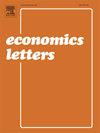短期电力需求的弹性如何?
IF 2.1
4区 经济学
Q2 ECONOMICS
引用次数: 0
摘要
本文考察了电力总需求如何响应每小时批发市场价格的变化。我关注的是一个水力资源丰富的国家,并使用进口风能和累积降水的数据作为价格工具。使用瑞士2016年至2023年的数据,我发现这两种工具都具有强烈而显著的价格抑制效应,我估计总需求的价格弹性为- 0.1。然而,这种反应完全是由存储系统和发电厂的消费驱动的,而最终用户的需求在短期内对价格波动完全没有弹性。本文章由计算机程序翻译,如有差异,请以英文原文为准。
How (In)elastic is the short-run demand for electricity?
This paper examines how the aggregate demand for electricity responds to changes in hourly wholesale market prices. I focus on a hydropower-rich country and use data on imported wind energy and accumulated precipitation as instruments for price. Using data from Switzerland from 2016 to 2023, I find that both instruments have a strong and significant price-depressing effect, and I estimate the price elasticity of aggregate demand to be . However, this responsiveness is entirely driven by the consumption of storage systems and power plants, while end-user demand remains perfectly inelastic to price fluctuations in the short-run.
求助全文
通过发布文献求助,成功后即可免费获取论文全文。
去求助
来源期刊

Economics Letters
ECONOMICS-
CiteScore
3.20
自引率
5.00%
发文量
348
审稿时长
30 days
期刊介绍:
Many economists today are concerned by the proliferation of journals and the concomitant labyrinth of research to be conquered in order to reach the specific information they require. To combat this tendency, Economics Letters has been conceived and designed outside the realm of the traditional economics journal. As a Letters Journal, it consists of concise communications (letters) that provide a means of rapid and efficient dissemination of new results, models and methods in all fields of economic research.
 求助内容:
求助内容: 应助结果提醒方式:
应助结果提醒方式:


